The 3D Sensor Market is estimated to be valued at USD 5.0 billion in 2025 and is projected to reach USD 50.4 billion by 2035, registering a compound annual growth rate (CAGR) of 26.0% over the forecast period.
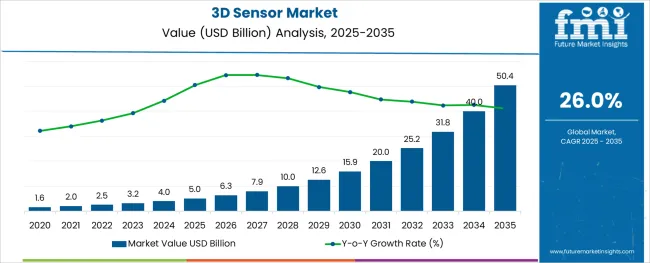
The 3D sensor market is expanding at a steady pace, supported by the rapid integration of depth sensing in smartphones, gaming consoles and smart home devices. Technological developments have made 3D sensors smaller and more energy efficient enabling their use in compact consumer electronics. Consumer demand for immersive digital experiences such as facial recognition gesture control and augmented reality has driven manufacturers to incorporate advanced sensors into their devices.
Industry updates and product launches have shown that Time of Flight and structured light technologies are being optimized for faster data capture and enhanced accuracy. Additionally industries such as automotive and industrial automation are exploring 3D sensors for object detection and navigation but consumer electronics remains the largest application.
Looking ahead market growth will be driven by rising demand for contactless interaction and advancements in AI powered sensor processing. Segmental leadership is expected from Image Sensors in product type Time of Flight in technology and Consumer Electronic Application in end use.
The market is segmented by Product Type, Technology, and Application and region. By Product Type, the market is divided into Image Sensors, Position Sensors, Pressure Sensors, CMOS 3D Image Sensors, 3D Electro Optical Image Sensors, 3D Time of Flight Image Sensors, Temperature Sensors, and Others. In terms of Technology, the market is classified into Time of Flight Technology, Structured Light, Ultrasound, and Stereo Vision.
Based on Application, the market is segmented into Consumer Electronic Application, Medical Application, Automotive application, Industrial Application, Media & Entertainment Application, Aerospace & Defence Application, and Others. Regionally, the market is classified into North America, Latin America, Western Europe, Eastern Europe, Balkan & Baltic Countries, Russia & Belarus, Central Asia, East Asia, South Asia & Pacific, and the Middle East & Africa.
The market is segmented by Product Type, Technology, and Application and region. By Product Type, the market is divided into Image Sensors, Position Sensors, Pressure Sensors, CMOS 3D Image Sensors, 3D Electro Optical Image Sensors, 3D Time of Flight Image Sensors, Temperature Sensors, and Others. In terms of Technology, the market is classified into Time of Flight Technology, Structured Light, Ultrasound, and Stereo Vision. Based on Application, the market is segmented into Consumer Electronic Application, Medical Application, Automotive application, Industrial Application, Media & Entertainment Application, Aerospace & Defence Application, and Others. Regionally, the market is classified into North America, Latin America, Western Europe, Eastern Europe, Balkan & Baltic Countries, Russia & Belarus, Central Asia, East Asia, South Asia & Pacific, and the Middle East & Africa.
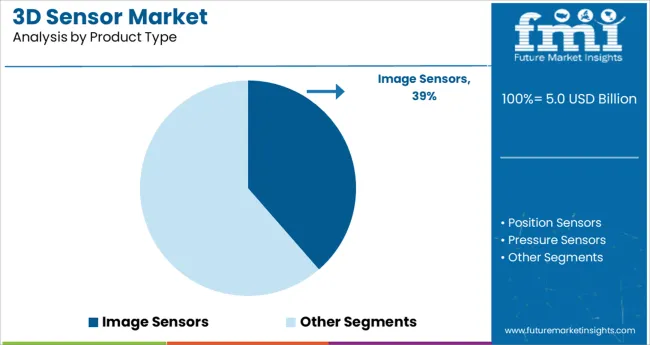
The Image Sensors segment is projected to capture 38.6% of the 3D sensor market revenue in 2025 making it the leading product type. Growth in this segment has been fueled by the increasing adoption of imaging sensors that capture depth and spatial data alongside traditional two dimensional images. Consumer electronics have widely adopted image sensors for front facing cameras where they enable facial recognition and gesture detection.
Manufacturers have improved pixel density and light sensitivity in these sensors allowing for greater accuracy in low light and dynamic environments. The versatility of image sensors in both still image capture and depth mapping has made them the foundation of most 3D sensing systems.
As user expectations continue to rise for enhanced visual and interactive experiences Image Sensors are expected to maintain their prominent role in the market.
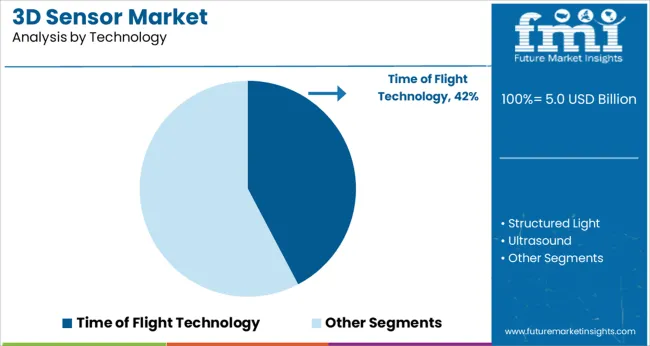
The Time of Flight Technology segment is expected to account for 42.3% of the 3D sensor market revenue in 2025 holding the top spot in technology segments. Growth of this segment has been driven by its ability to provide fast and accurate depth sensing by measuring the time it takes light pulses to reflect off objects.
This technology has been adopted across various consumer devices due to its compact design and ability to deliver real time three dimensional data. Compared to other depth sensing methods Time of Flight has been valued for its efficient range detection and adaptability in both indoor and outdoor environments.
Its integration into smartphones and gaming devices has enhanced user experiences in photography augmented reality and gesture-based controls. As product designers seek to deliver seamless interaction capabilities Time of Flight Technology is expected to remain the preferred choice for 3D sensing.
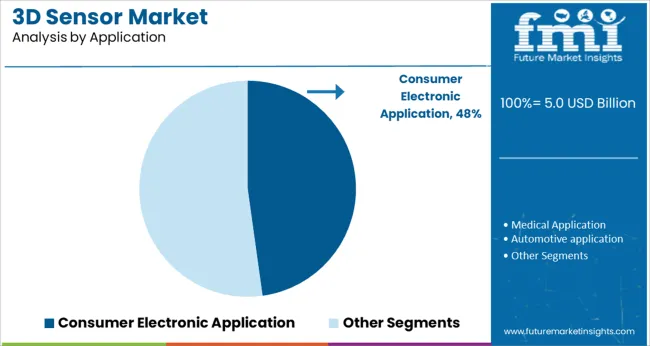
The Consumer Electronic Application segment is projected to represent 47.8% of the 3D sensor market revenue in 2025 leading the application segments. This growth has been supported by the widespread use of 3D sensors in smartphones tablets gaming systems and smart home devices.
Consumers have increasingly sought out products with enhanced interactivity such as facial recognition secure authentication and augmented reality experiences. Electronics manufacturers have integrated 3D sensing capabilities to meet these demands while also improving product safety and ease of use.
The rising trend of contactless device interaction has further boosted the adoption of 3D sensors in this segment. Additionally the fast pace of product refresh cycles in consumer electronics has led to continual updates in sensor technology driving sustained demand. As personal technology continues to evolve the Consumer Electronic Application segment is expected to hold its position as the primary driver of 3D sensor market growth.
Rapid growth of consumer electronics industry, growing popularity of 3D sensors in the automotive sector, innovations in sensing technology and rising need for better security & surveillance are some of the major factors driving the 3D senor market.
During the last few years, 3D sensors have gained immense traction on account of their ability to detect the size, shape, and distance of objects within their field of vision. They use technologies like structured light, ultrasound, stereo vision, time of flight technology to recognize the objects in the space and provide accurate data.
3D sensors find their application in various modern day electronic products ranging from cameras, smartphones, and drones to robots. Rising production and sales of these consumer electronic products is set to boost the growth of 3D sensors market in the future.
Growing popularity of autonomous cars coupled with increasing prevalence of automotive accidents is creating growth avenues within the 3D sensor market. These sensors have become essential components for increasing the safety of both drivers and passengers by detecting the people and objects in the vicinity of the car.
Products like 3D image sensors are being integrated in advanced driver assistance systems (ADAS) to provide parking assistance, collision avoidance and lane departing warning.
Subsequently, the advent of virtual reality and augmented reality in the gaming sector is proving a major thrust to the growth of 3D sensor market. These sensors are used to control games and entertainment devices by mere gesture.
In addition to this, growing adoption of 3D sensors in medical imaging solutions and surveillance cameras will further accelerate the growth of 3D sensor market over the assessment period.
Despite increasing penetration of 3D sensors, there are numerous obstacles likely to pose a challenge to market growth.
Factors such as high maintenance costs, lack of manufacturing excellence and limited integration with some devices are emerging as major impediments for the growth of 3D sensor market. 3D sensors are usually expensive. As a result, many electronics manufacturers refrain from integrating them (3D sensors) into cheaper electronic products.
As per Future Market Insights, Asia pacific Excluding Japan (APEJ) is projected to emerge as the fastest growing market for 3D sensors during the forecast period. Rapid expansion of consumer electronics and automotive industries, growing popularity of 3D sensing technologies in safety and surveillance applications and heavy presence of leading market players are some of the factors boosting the sales of 3D sensors across APEJ region.
Countries such as China and South Korea are becoming hub of consumer electronic products in the world. These countries export a huge volume of consumer electronic products including smartphones and cameras to different regions of the world. This rise in production and sales of consumer electronics is emerging as a key factor fostering the growth of 3D sensors market.
Major companies based in APEJ like Samsung (South Korea), Oppo (China), Xiaomi (China) etc. are continuously integrating 3D sensors in their smartphones to enhance the performance and quality of cameras.
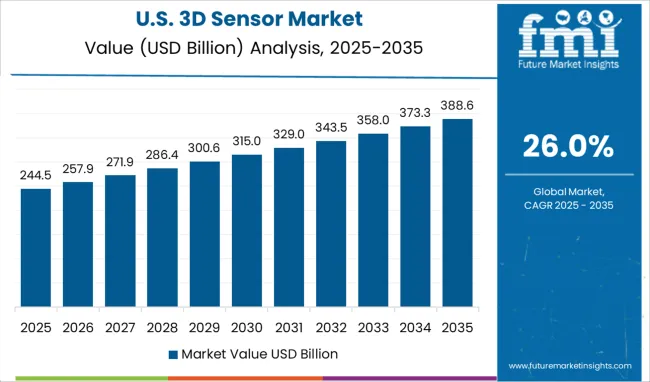
Currently North America dominates the 3D sensor market and the trend is likely to continue in the future, owing to the growing demand for 3D sensors from consumer electronics and automotive sectors.
Countries such as the United States are witnessing high demand for medical imaging solutions, smartphones and autonomous vehicles. Rising sales of these products is anticipated to ignite the sales of 3D sensors during the forecast period.
3D sensors have become essential components in consumer electronics for the measurement of objects or scenes in 3 dimensions. These sensors are being used in diverse products ranging from security cameras, self-driving vehicles, mobiles etc. Furthermore, increasing usage of 3D sensors in drones and robots is expected to trigger the growth of 3D sensor market in the North American region.
Majority of the manufacturing industries in the region are using 3D sensors to detect faults in the shape and sizes of the produced products. Expansion of these manufacturing industries will further create growth prospects for 3D sensor market in the region.
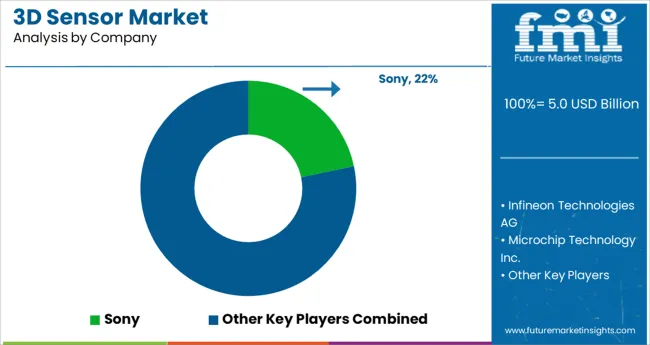
Some of the key participants present in the global 3D sensor market include Infineon Technologies AG, Sony Cognex Corporation, LMI Technologies Inc., SOFTIKINETIC, Optima S.A., ifm Efector, Inc., Occipital, Inc., ASUSTeK Computer Inc. and Panasonic Corporation among others.
The global 3D sensors market is highly competitive in nature with leading market players constantly upgrading their product portfolios. They are aiming at developing innovative solutions that can even penetrate through sold obstacles like walls.
| Report Attribute | Details |
|---|---|
| Growth Rate | CAGR of 26.0% from 2025 to 2035 |
| Base Year for Estimation | 2024 |
| Historical Data | 2020 to 2024 |
| Forecast Period | 2025 to 2035 |
| Quantitative Units | Revenue in USD Million, Volume in Kilotons and CAGR from 2025 to 2035 |
| Report Coverage | Revenue Forecast, Volume Forecast, Company Ranking, Competitive Landscape, Growth Factors, Trends and Pricing Analysis |
| Segments Covered | Product Type, Technology, Application, Region |
| Regions Covered | North America; Latin America; Western Europe; Eastern Europe; APEJ; Middle East and Africa |
| Key Countries Profiled | USA, Canada, Brazil, Argentina, Germany, UK, France, Spain, Italy, Nordics, BENELUX, Australia & New Zealand, China, India, ASEAN, GCC, South Africa |
| Key Companies Profiled | Infineon Technologies AG; Cognex Corporation; LMI Technologies Inc.; SOFTIKINETIC; Optima S.A.; ifm Efector, Inc.; Occipital, Inc.; ASUSTeK Computer Inc.; Panasonic Corporation |
| Customization | Available Upon Request |
The global 3d sensor market is estimated to be valued at USD 5.0 billion in 2025.
It is projected to reach USD 50.4 billion by 2035.
The market is expected to grow at a 26.0% CAGR between 2025 and 2035.
The key product types are image sensors, position sensors, pressure sensors, cmos 3d image sensors, 3d electro optical image sensors, 3d time of flight image sensors, temperature sensors and others.
time of flight technology segment is expected to dominate with a 42.3% industry share in 2025.






Full Research Suite comprises of:
Market outlook & trends analysis
Interviews & case studies
Strategic recommendations
Vendor profiles & capabilities analysis
5-year forecasts
8 regions and 60+ country-level data splits
Market segment data splits
12 months of continuous data updates
DELIVERED AS:
PDF EXCEL ONLINE
3D Imaging Surgical Solution Market Size and Share Forecast Outlook 2025 to 2035
3D Printing Industry Analysis in Middle East Size and Share Forecast Outlook 2025 to 2035
3D Printed Dental Brace Market Size and Share Forecast Outlook 2025 to 2035
3D Reverse Engineering Software Market Forecast and Outlook 2025 to 2035
3D Automatic Optical Inspection Machine Market Size and Share Forecast Outlook 2025 to 2035
3D Ready Organoid Expansion Service Market Size and Share Forecast Outlook 2025 to 2035
3D-Printed Prosthetic Implants Market Size and Share Forecast Outlook 2025 to 2035
3D Printing Ceramics Market Size and Share Forecast Outlook 2025 to 2035
3D NAND Flash Memory Market Size and Share Forecast Outlook 2025 to 2035
3D Printing Metal Market Size and Share Forecast Outlook 2025 to 2035
3D Bioprinted Organ Transplants Market Size and Share Forecast Outlook 2025 to 2035
3D Mapping and Modeling Market Size and Share Forecast Outlook 2025 to 2035
3D Audio Market Size and Share Forecast Outlook 2025 to 2035
3D Printing in Aerospace and Defense Market Analysis - Size, Share, and Forecast Outlook 2025 to 2035
3D Printed Maxillofacial Implants Market Size and Share Forecast Outlook 2025 to 2035
3D Surgical Microscope Systems Market Size and Share Forecast Outlook 2025 to 2035
3D-Printed Personalized Masks Market Size and Share Forecast Outlook 2025 to 2035
3D Printing Market Size and Share Forecast Outlook 2025 to 2035
3D Printed Packaging Market Size and Share Forecast Outlook 2025 to 2035
3D Printed Clear Dental Aligners Market Size and Share Forecast Outlook 2025 to 2035

Thank you!
You will receive an email from our Business Development Manager. Please be sure to check your SPAM/JUNK folder too.
Chat With
MaRIA